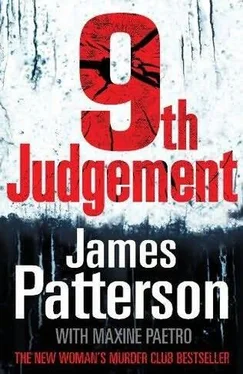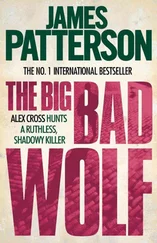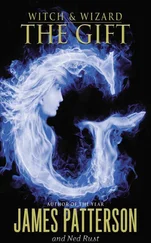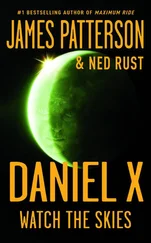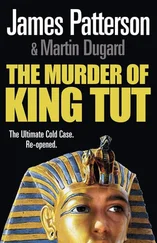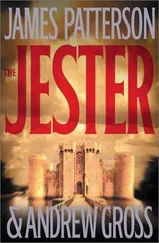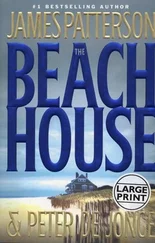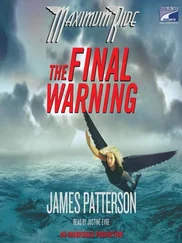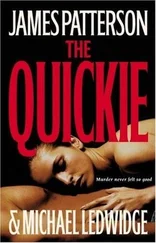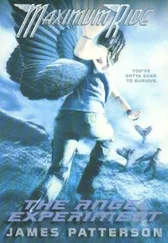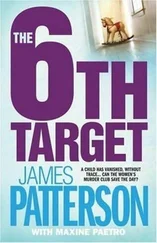I saw the mother first. She’d fallen onto her back. Her pale-blue cardigan was black over her heart from the two shots to the center mass, and she’d taken another gunshot wound to the head. I reached over and closed her sightless eyes.
Only then could I bear to look at the small, still figure lying near her.
Damn it, he’d killed the child.
This scene was a horror, and even as I recoiled from the brutality, I was struck by how methodical these shootings had been. They had been impersonal, dead-on shots fired at close range.
Jacobi stepped aside and I circled the body of the child in the capsized stroller, a boy under the age of one. I didn’t need to say to Jacobi that it was obvious these killings and the ones in the Stonestown garage were the work of the same killer.
But where was his signature? Where were the letters “WCF”?
Jacobi dropped the young mother’s wallet into an evidence bag. “This is Judy Kinski. She had forty dollars in small bills. Two charge cards. Library card. She would have been twenty-six years old next week. McNeil is contacting her next of kin.”
“Witnesses?” I asked. “Someone had to see this go down.”
“Chi is talking to the ticket seller. Come with me.”
THE GIRL IN the movie-theater manager’s office was crying into her hands. She looked up when I entered the tiny space. Paul Chi introduced me to the pale young woman and said, “This is Robin Rose. She may have seen the shooter.”
“Is my mother here?” Robin asked.
Jacobi said, “She’s on her way. As soon as she arrives, we’ll escort you down.”
“I didn’t see the shootings,” the girl said between sobs. “I was opening the booth for the seven o’clock show.”
Chi handed her a wad of tissues and told her it was all right, to take her time.
“I didn’t hear anything,” she said, blowing her nose. “But when I rolled up the window…”
I could see it through her eyes. The last moments of her innocence, opening the cash drawer, checking the ticket feed, rolling up the metal security window, expecting-what? A couple of people wanting to buy their tickets early?
“I didn’t believe it at first,” Robin told us. “I thought it was some kind of alternative advertising for an upcoming show. Then I realized that those people were real . That they were dead. ”
“Did you see anyone near the bodies?” I asked.
She nodded and said, “He must’ve heard the window go up. He met my eyes for a fraction of a second. I saw the gun, so I ducked down.”
The man Robin Rose saw was a white male, wearing a blue-and-white baseball jacket and a cap pulled down over his eyes. She didn’t think she could describe him, but she would try. Same with his gun. And she didn’t see which exit he took out of the mall.
Maybe he’d taken the skywalk over to another of the malls in the Embarcadero Center, or he could just as easily have gone down the escalator and out onto the street.
I asked Robin if she’d come in to the station to look at surveillance tape, and then I left the manager’s office with Jacobi. He was putting out an APB on a white male in a blue-and-white baseball jacket when Claire stomped up the escalator with her chief assistant, Bunny Ellis, behind her.
Claire wore a furious look as she moved in on the victims’ bodies with her Minolta. I stood next to her as she said to me, “Lookit. Same weird stippling, Lindsay. Same point-blank shooting. Same bastard kid killer. Was anything stolen?”
“Mom’s wallet was full.”
It was Claire who saw the writing on the underside of the stroller.
I stared at the letters as cameras flashed in a stroboscopic frenzy. The message was written in lipstick. The signature was the same-but different.
FWC
“What the hell?” I said to Claire. “Not WCF? Now it’s FWC?”
“You ask me, Lindsay? This guy isn’t leaving clues. He’s purely fucking with us.”
OUR PINCH HITTER, Jackson Brady, said he’d taken workshops at the FBI headquarters in Quantico.
“I spent two full summers learning to profile serial killers. That doesn’t make me a pro, but I have educated opinions.”
Jacobi commandeered a conference room in the Crimes Against Persons Division, and we all sat around the chipped fake-wood table, looking at Brady. Paul Chi told Brady what we’d gathered from the first scene and the latest, and Brady took notes.
All eyes were on him when he told us, “Killing children is reactive, maybe to a bad childhood, or it’s possible this killer is so dead inside, he just wastes the kids because they’re witnesses.”
“The kids were babies,” Jacobi said.
Brady shrugged. “The killer probably isn’t using that kind of logic. As for the killing of the mothers, you’re seeing a real hatred for women.”
“In terms of finding this guy,” Jacobi said, “his early childhood isn’t relevant, is it? How he feels isn’t going to lead us to him.”
“You’re right, Lieutenant. In fact, I’m going to say this guy can hide in plain sight. Look at what you know from the way he committed the crimes, how he got away without being seen. He’s highly intelligent, he’s focused, he’s organized, and he’s working alone. Most important, he passes as ordinary. That’s the only way he could get so close to his victims. They don’t even scream.”
“And he’s got a gun that doesn’t bring up a hit,” I said.
“That’s an interesting detail,” Brady said. “This guy knows weaponry. Makes me think he may have military training.”
“We’ve got a witness ID and video surveillance,” I said. “We think we have some idea what he may look like.”
“Nothing distinctive, am I right?”
“Yeah,” said Chi. “White male, thirties, wears a cap. We’ll get another look when we go over the security tapes from One EC.”
Conklin asked, “If this guy is military, if he’s at least highly competent and trained, what’s going to trip him up?”
“Overconfidence,” Brady said. “He could get too sure of himself and leave a clue. But, you know, it could be a long time before he makes that kind of mistake.”
I sat back in my seat. It was another way of saying what I’d been thinking since the Bentons were killed in the Stones-town garage.
More people were going to die.
TEN DAYS AGO, “Dowling trumped everything.”
Now the entire threadbare Homicide squad plus dozens of conscripted cops from other departments were canvassing the Embarcadero Center, following up every phoned-in, crackpot lead, working twelve-hour shifts under Jacobi in single-minded determination to nail the Lipstick Killer.
I was in the morgue with Claire when the ballistics report from the Feds was dropped into her in-box. I tried not to scream out my impatience as she carried on a phone call while gingerly peeling up the envelope flap. She finally hung up on her caller and took out the single sheet of paper. She skimmed the page and said, “Hey-hey. Our case was reviewed by Dr. Mike himself.”
“Forgive my ignorance-and will you please give me the damned report?”
“Hang on, girlfriend. Dr. Michael Sciarra is the FBI’s Dr. Gun,” she said. “Okay. Lemme get to the nub here. Dr. Mike says the gunpowder stippling on those dead babies was atypical because the shots were fired through a suppressor. And not your basic pop-bottle-and-scouring-pad wackadoo, either.”
“What, then?” I asked.
“It had to be professionally tooled, cold steel or titanium. Very few of these exist. Dr. Mike says here, ‘There is no record of any homicides in the United States committed with a suppressor like the one that caused the atypical stippling pattern on the Benton and Kinski children.’”
Читать дальше
